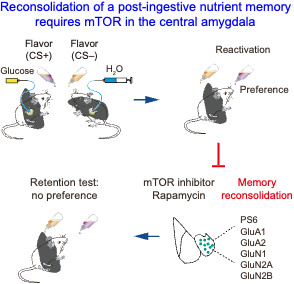
The central control of feeding behavior and metabolic homeostasis has been proposed to involve a form of post-ingestive nutrient learning independent of the gustatory value of food. However, after such learning, it is unknown which brain regions or circuits are activated to retrieve the stored memory and whether this memory undergoes reconsolidation that depends on protein synthesis after its reactivation through retrieval. In the present study, using a conditioned-flavor-preference paradigm by associating flavors with intra-gastric infusion of glucose to minimize the evaluation of the taste of food, we show that retrieval of the post-ingestive nutrient-conditioned flavor memory stimulates multiple brain regions in mice, including the central nucleus of the amygdala (CeA). Moreover, memory retrieval activated the mammalian target of rapamycin complex 1 (mTORC1) in the CeA, while site-specific or systemic inhibition of mTORC1 immediately after retrieval prevented the subsequent expression of the post-ingestive nutrient-associated flavor memory, leading to a long-lasting suppression of reinstatement. Taken together, our findings suggest that the reconsolidation process of a post-ingestive nutrient memory modulates food preferences. This work was published in Molecular Psychiatry in 2021 (DOI: 10.1038/s41380-020-00874-5).